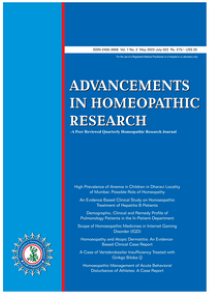Development and Validation of a Scale to Clinically Assess Overall Hair and Scalp Condition – A Pilot Study
DOI:
https://doi.org/10.48165/ahr.2024.9.2.2Keywords:
Alopecia Scoring Scale, Cronbach’s alpha coefficient, Pearson’s co-relation coefficient, Reliability, ValidityAbstract
Background: Existing scales for Alopecia measures severity and stages, all of which are made for individual types, none of the existed ones can be applied to all types and no one focuses on the clinical symptoms which patient addresses while case taking or can be used to assess the clinical outcomes. So, a scale was developed on the basis of existing literatures which can assess the clinical outcomes and can be apply for all types of alopecia. Objective: To develop alopecia scoring scale to clinically assess overall hair and scalp condition based on compilation of existing literature and to test the reliability and validity of alopecia scoring scale. Material & Methodology: Alopecia scoring scale was derived after thorough literature review. A pilot study was conducted on 30 patients who are clinically diagnosed with alopecia in July 2021 at Swasthya Kalyan Homoeopathic Medical College & Research Centre, Sitapura, Jaipur. Result: The internal consistency of scale were estimated by Cronbach Alpha Coefficient which was found to be generally satisfactory. The Cronbach Alpha reliability coefficient 0.82 which suggests it was found to be reliable. Pearson’s Co-relation Coefficient obtained value is > 0.7 which is greater than critical value of 0.361 at df 28 and is highly significant, so it is a valid scale. Conclusion: The Alopecia Scoring Scale is the valid and reliable tool to clinically access all types of Alopecia patients. It might serve as a useful tool to monitor disease status over time, and to guide treatment decisions.
References
Gupta M, Mysore V. Classifications of patterned hair loss: A review. J Cutan Aesthet Surg. 2016;9(1):3– 12.
King BA, Senna MM, Ohyama M, Tosti A, Sinclair RD, Ball S, et al. Defining severity in alopecia areata: Current perspectives and a multidimensional framework. Dermatol Ther (Heidelb). 2022;12(4):825–34.
Olsen EA, Roberts J, Sperling L, Tosti A, Shapiro J, McMichael A, et al. Objective outcome measures: Collecting meaningful data on alopecia areata. J Am Acad Dermatol. 2017;79(3):470.
Wyrwich KW, Kitchen H, Knight S, Aldhouse NVJ, Macey J, Nunes FP, et al. The Alopecia Areata Investigator Global Assessment scale: a measure for evaluating clinically meaningful success in clinical trials. Br J Dermatol. 2020;183(4):702–9
King BA, Mesinkovska NA, Craiglow B, Kindred C, Ko J, McMichael A, et al. Development of the alopecia areata scale for clinical use: Results of an
academic-industry collaborative effort. J Am Acad Dermatol. 2022;86(2):359–64.
Shapiro Jerry. Hair Loss: Principles of Diagnosis and Management of Alopecia. p. 1-13
Piérard-Franchimont C, Xhauflaire-Uhoda E, Piérard GE. Revisiting dandruff. Int J Cosmet Sci. 2006;28(5):311–8.
Reich A, Szepietowski JC. Pruritus intensity assessment: challenge for clinicians. Expert Rev Dermatol. 2013;8(3):291–9.
G. H. Guyatt,D. H. Feeny, andD. L. Patrick, “Measuring healthrelated quality of life,” Annals of Internal Medicine, vol. 118, no. 8, pp. 622–629, 1993.
L. J. Cronbach, “My current thoughts on coefficient alpha and successor procedures,” Educational and Psychological Measurement. A Bimonthly Journal Devoted to the Development and Application of Measures of Individual Differences, vol. 64, no. 3, pp. 391–418, 2004.
Gupta Y et al. Psychosomatic disease Alopecia with Acrophobia and Individualized Homoeopathy– A Retrospective Analysis. The Homoeopathic Heritage. 2023;49(7):90-95 https://www.researchgate.net/ publication/375486043_Psychosomatic_disease_ Alopecia_with_Acrophobia_and_Individualized_
Homoeopathy-_A_Retrospective_Analysis




